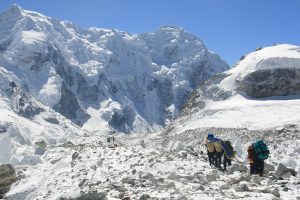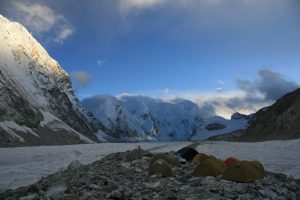2 October 2018
Tracking exploding ice cracks on Himalayan glaciers
Posted by llester
By Joshua Rapp Learn
In 2017, Evgeny Podolskiy spent more than a week trekking through the Nepalese Himalayas to test the seismic activity of the Trakarding-Trambau Glacier system. In October, the research team and a group of sherpas and porters traveled to an open, debris-free glacier about five kilometers (3.1 miles) above sea level, in full view of Mount Everest.

Researchers, sherpas and porters trekking along the Trakarding-Trambau Glacier System to research the seismic noise of ice in the Himalayas in Nepal. Credit: Podolskiy
“It was an amazing experience because it’s such a magnificent area to work in. Basically I have lunch looking at Everest,” said Podolskiy, a glaciologist working at the Arctic Research Center in Hokkaido University, Japan.
But the researchers felt the real shock in their tents after dark. “We hear this loud boom,” Podolskiy said. “We noticed that our glacier is bursting, or exploding with cracks at night.”
Podolskiy couldn’t see what was happening, but during the three weeks he and his colleagues were kept up shivering in their tents listening to the noise, Podolskiy began to suspect there was some difference between the day and night, possibly due to temperature changes, that was causing the booms. It wasn’t until Podolskiy was back in the office and he looked at the seismographic data the researchers gathered in the field that he discovered what was happening.
The researchers found abrupt nightly temperature drops due to the glacier’s high altitude caused the explosive cracks. Podolskiy says while the temperature could drop to around -15 degrees Celsius (5 degrees Fahrenheit) at night, the researchers would often be working in t-shirts by day.
While much of the glacier was protected from such large temperature swings by a thick blanket of debris, the areas of open surface of the ice were more vulnerable to the elements. When the temperature dropped, the glacier would contract, leading to a great deal of minute ice cracks which caused ice quakes. The very largest of these cracks were heard by the scientists at night, though their seismographs picked up a lot of additional smaller action.
The authors of the new study describing the phenomenon note this is the first time such a large amount of seismic activity due to the thermal fracturing has been observed at relatively warm temperatures and outside polar regions.

The researchers camp on the open glacier. At night here they heard loud booms, which they later discovered were caused by the extreme temperature shifts between day and night. Credit: Podolskiy
“Local ice turns out to be very sensitive to this high rate of change,” said Podolskiy, who is the lead author of a new study in Geophysical Research Letters, a journal of the American Geophysical Union.
The new research could help scientists monitor the behavior of glaciers in remote areas like the Himalayas. Podolskiy said the Himalayas have one of the largest stores of ice on Earth, but there has been little research on glacier cracking there. These glaciers are also losing mass much faster than the global average, and researchers are currently uncertain about the causes.
Podolskiy said researchers often focus on the noisy end of glaciers, which break apart in massive calving events in the Arctic or Antarctica and produce ice quakes. However, relatively little attention has been focused on measuring the more passive seismic noise of slowly flowing glaciers at high altitudes.
Advances in seismic technology now allow researchers to detect vibrations down to the micrometer, allowing for the characterization and continuous monitoring of processes otherwise nearly impossible to observe.
The seismic noise of glaciers can also be used to monitor the near-surface structure and the damage state of ice. Learning more about how these processes work is critical as they could also play a large role in glacial mass loss, which can contribute to sea level changes, according to the study’s authors.
While the scientific discoveries were important for the future of glaciology, Podolskiy said the expedition was also thrilling on a personal level.
“It was a big adventure for myself and for the landscape,” he said.
—Joshua Rapp Learn is a freelance science writer based in Washington, DC.










 GeoSpace is a blog on Earth and space science, managed by AGU’s Public Information staff. The blog features posts by AGU writers and guest contributors on all sorts of relevant science topics, but with a focus on new research and geo and space sciences-related stories that are currently in the news.
GeoSpace is a blog on Earth and space science, managed by AGU’s Public Information staff. The blog features posts by AGU writers and guest contributors on all sorts of relevant science topics, but with a focus on new research and geo and space sciences-related stories that are currently in the news.
In the above write-up it’s mentioned that the glaciers contract with decreasing night time temperature shifts. It’s also mentioned that the researchers were wearing t-shirts during daytime operations. It seems an obvious explanation is being completely overlooked. First, as everyone knows, water expands when it freezes. So just like rocks weathering with water in the fissures freezing on cold nights, why isn’t the same reasoning considered or discounted in this case? A lot of water pooling in cracks, freezing during the night and blowing apart the ice.